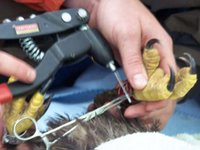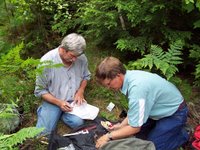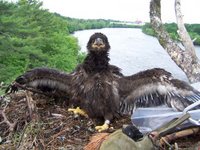June 30 notes: the trials & tribulations of fledgling eaglets
Many are concerned for its fate because this maiden voyage looked more like a flop / fall than a flight. Fear not: I called a neighbor who sees the bird on a limb beneath the nest, while "big sister" remains in the nest. As Mark described in our last Journal entry, nothing surprises us about first flights, first landings, and the entire early fledging period. It is indeed a high risk time, and therefore, perhaps more compelling to watch. We have zoomed out the camera to give a wider angle view of the entire nest and surrounding lateral limbs of the nest tree so perhaps more of the process will be in view for those who dare to watch!
Actually, all is going well at the eagle cam. Here are some brief notes from other nests around Maine to give you a taste of the many challenges faced by nesting eagles:
A Sagadahoc County nest has triplets when Chris DeSorbo and I visited the nest on May 15. Chris and Bill Hanson combine to band eaglets and obtain blood samples for monitoring dietary mercury. One of the three 4-week old eaglets is smaller than its siblings. Since Maine is planning to donate an eaglet from 3 different nests to a reintroduction in Vermont, we immediately broach the idea of removing one here with the very conscientious landowners who are agreeable. We have to wait to find a "set" of appropriately aged eaglets. Chris visits 3 weeks later and finds only two eaglets: a repeat incident of what happened a few weeks earlier at this eagle cam. The same outcome reduces broods of 3 eaglets at a nest in Kennebec County and one in Waldo County. When food is limiting or harsh elements challenge an adult's ability to care for all nestlings, only the strongest survive. We look elsewhere for eaglet donations to Vermont.
A Penobscot County nest with poor productivity has been closely monitored since March as part of special research monitoring dioxins in Maine eagles. It's a priority sampling site for the mercury study as well. Two addled eggs were recovered here in 2005. We are all pleased by their apparent success this year when my May 23 flight revealed two 4-week old eaglets standing in the nest. On a June 1 flight, only scattered remains of both dead eaglets are visible: the victims of scavenging ... or possibly predation. Chris finds two 6-week old eaglets dead in a Washington County nest later in June that were likely killed by another predator. Our climbing crews have now recovered 5 dead eaglets in little over a week. Tissues will be tested.
On June 5, wildlife rehabilitator Anne Rivers follows up on a report that 2 eaglets are on the ground at a Hancock County nest. She retrieves them; feeds and rehydrates them for 3 dyas; and gets a veterinary exam, blood tests, and full body X-ray. I investigate the site and find the nest 100% fallen and a neighbor who has lost 10 hens to predators. The birds would not have fared well here, and they become (by default) our first "volunteers" to move to Vermont. They go home with me and get a 50-mile head start on their 400-mile trip. Haddock for dinner!
Good news from other locations: there are healthy sets of triplets at 3 Kennebec County nests. Eagles did not nest in Kennebec County between 1975 and 1994 as past declines decimated eagle numbers near Maine's state capital. One of the triplets is at the last Kennebec nest occupied in 1974 before their disappearance and where eagles returned to nest in 2001 after a 27-year absence. The landowner recalls when "his eagles" were the beneficiary of an egg transplant in 1974. The karma is good, and on June 8 we take the smallest eaglet away to join Maine's donation to Vermont. Bill Hanson climbs the tree on a very rainy day and soon after I am driving away with my wife holding a wet eaglet on the passenger seat so the bird will show up dry in Vermont. Only 10 miles down the road of its 250-mile journey our passenger shifts its weight, does a headstand, and does what all well-fed eaglets do. ("Eagle cam" watchers all know what happens next!) I am plastered by eagle poop at point-blank range. My sympathetic wife eventually stops laughing and orients the eaglet in another direction just in case. The transfer of 3 dry eaglets for Vermont is completed a few hours later. I look for a change of clothes!
Here's one final anecdote to show that sometimes we can remedy pending eaglet losses. Chris climbed another Sagadahoc County nest on June 12 and bands a 4-1/2 week old eaglet with large facial inflammations below its eyes. Bill Hanson returned to the nest on June 27 with wildlife rehabilitator / clinician Marc Payne who lanced the swollen sinuses and administered an antibiotic and sutures. It's pretty clear that this bird would not have made it without some help.
Management comments: Research at eagle nests and interventions with nestlings is always conducted in small windows of opportunity to minimize risks. Eaglets aged 4 - 7 weeks old can withstand the interruption and brief lack of parental care. Thus, we were not tempted to intervene at the "eagle cam" nest when the third eaglet was lost in just its third week: risks to its siblings could not be justified. Wildlife managers often prescribe timing safeguards to minimize potential disturbances near nesting eagles. The timing and unique circumstances of each location are considered in combination. As you watch fledgling eaglets in the difficult early stages of life out of the nest, please realize that this is another sensitive period when eagle nests can use all the privacy we can afford them. -- Charlie Todd, Maine Dept. of Inland Fisheries & Wildlife





